Corporate Accounting Report: Analysis of Financial Statements
VerifiedAdded on 2022/08/19
|10
|1262
|16
Report
AI Summary
This report provides an in-depth analysis of corporate accounting practices, focusing on the financial statements of Evolution Mining Ltd and Boral Ltd for the year 2019. The report examines the different sources of funds utilized by these companies, including equity and debt capital, and analyzes the changes in their capital structures over time. It also discusses the advantages and disadvantages of each fund source. Furthermore, the report explores the classification and reporting of assets and liabilities, with a particular emphasis on the requirements of AASB 137 concerning provisions, contingent liabilities, and contingent assets. The analysis highlights how both companies present their financial information, including disclosures related to liabilities and asset classifications, and concludes by summarizing the key findings regarding capital structure, reporting of extraordinary items, and overall financial performance. The report aims to provide a comprehensive understanding of corporate accounting principles in the context of the mining industry.
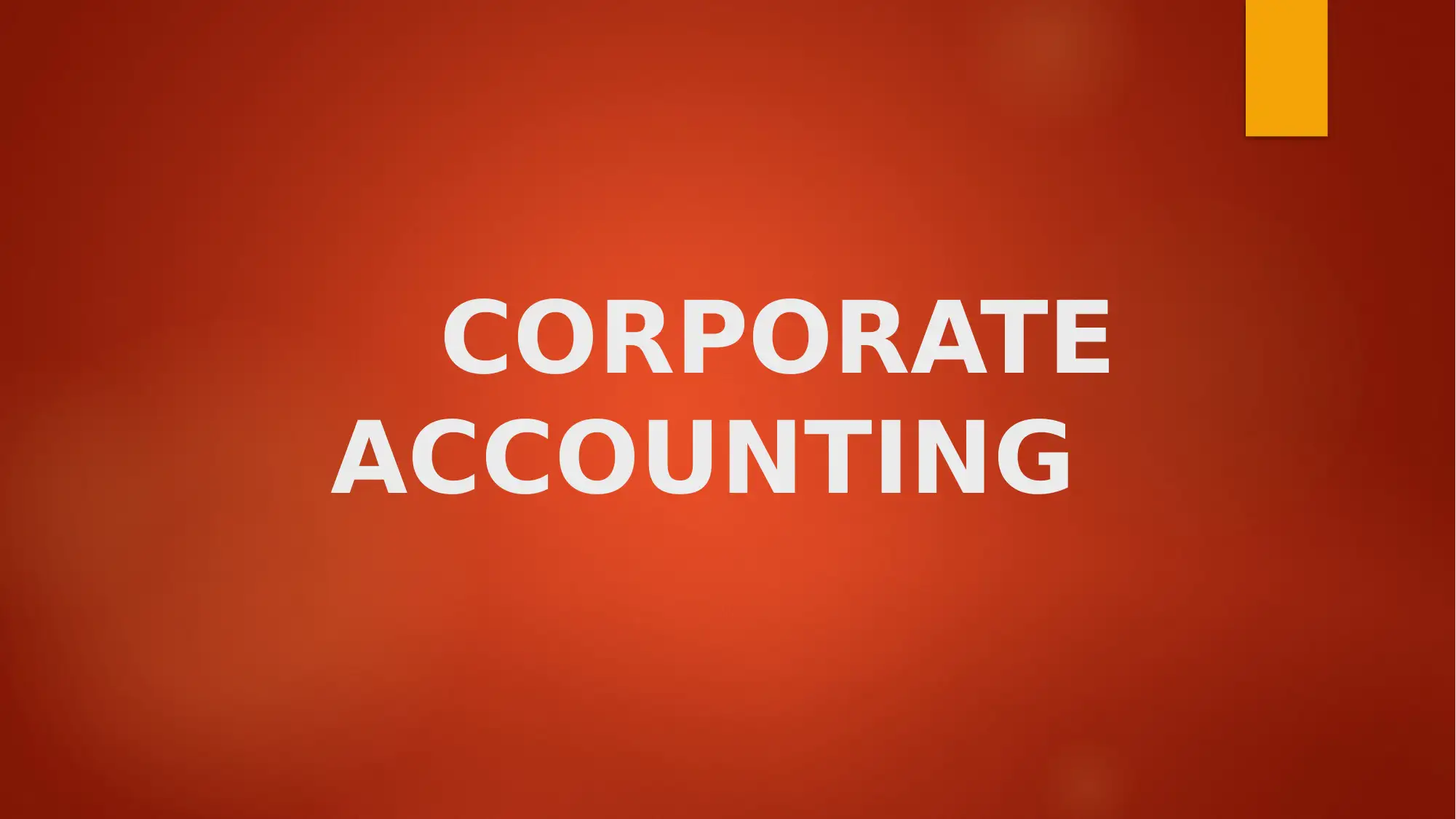
CORPORATE
ACCOUNTING
ACCOUNTING
Paraphrase This Document
Need a fresh take? Get an instant paraphrase of this document with our AI Paraphraser
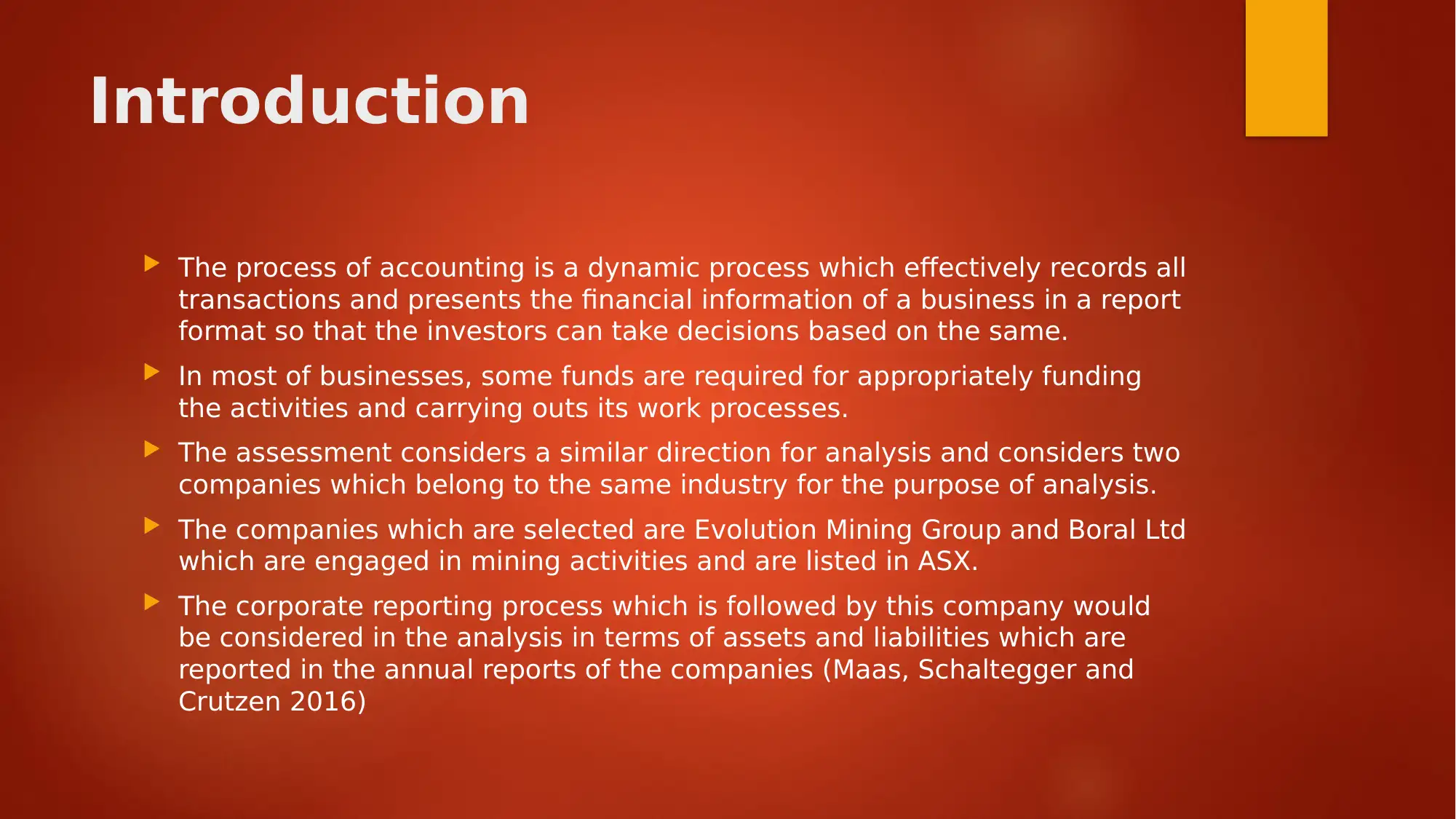
Introduction
The process of accounting is a dynamic process which effectively records all
transactions and presents the financial information of a business in a report
format so that the investors can take decisions based on the same.
In most of businesses, some funds are required for appropriately funding
the activities and carrying outs its work processes.
The assessment considers a similar direction for analysis and considers two
companies which belong to the same industry for the purpose of analysis.
The companies which are selected are Evolution Mining Group and Boral Ltd
which are engaged in mining activities and are listed in ASX.
The corporate reporting process which is followed by this company would
be considered in the analysis in terms of assets and liabilities which are
reported in the annual reports of the companies (Maas, Schaltegger and
Crutzen 2016)
The process of accounting is a dynamic process which effectively records all
transactions and presents the financial information of a business in a report
format so that the investors can take decisions based on the same.
In most of businesses, some funds are required for appropriately funding
the activities and carrying outs its work processes.
The assessment considers a similar direction for analysis and considers two
companies which belong to the same industry for the purpose of analysis.
The companies which are selected are Evolution Mining Group and Boral Ltd
which are engaged in mining activities and are listed in ASX.
The corporate reporting process which is followed by this company would
be considered in the analysis in terms of assets and liabilities which are
reported in the annual reports of the companies (Maas, Schaltegger and
Crutzen 2016)
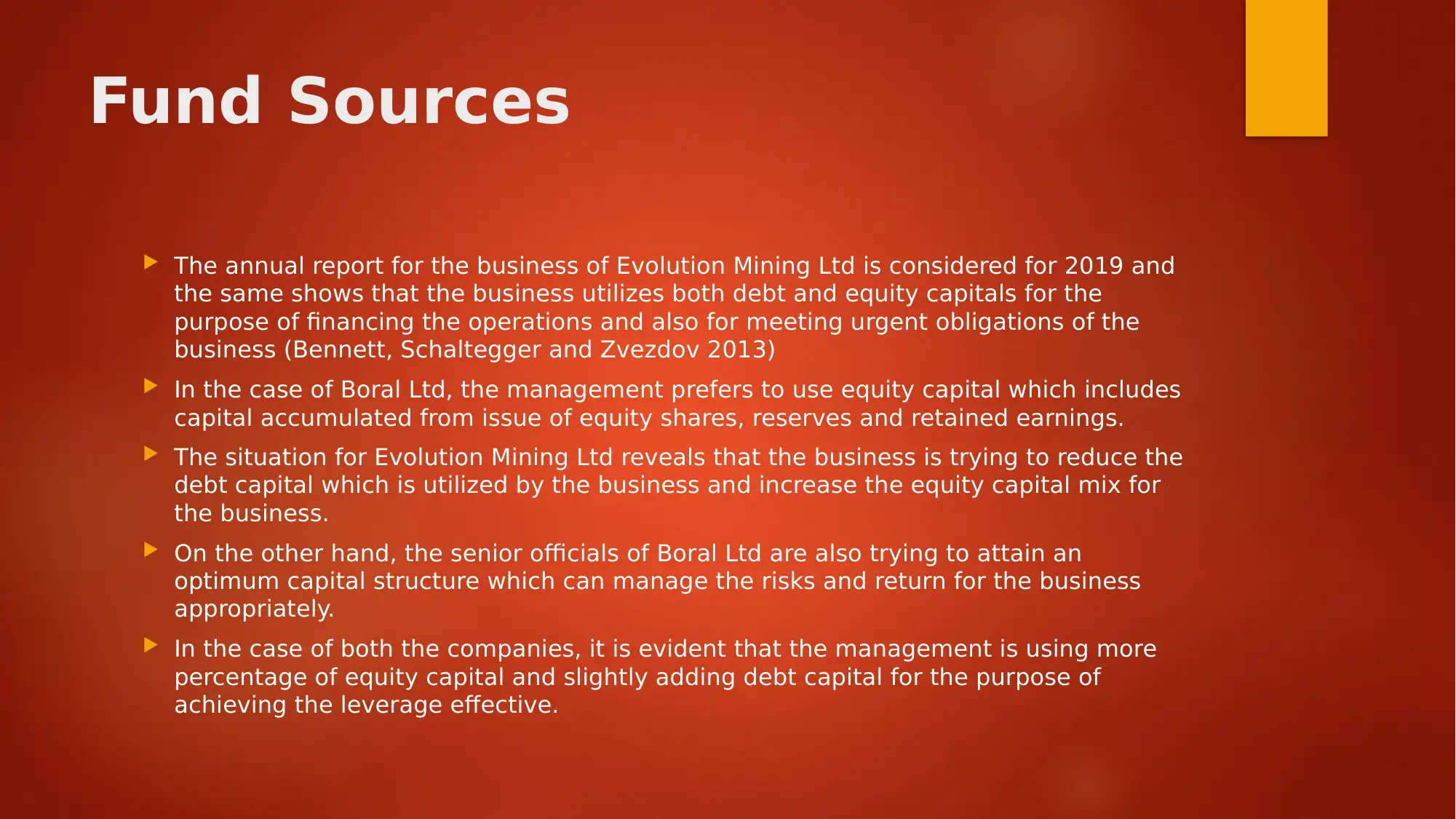
Fund Sources
The annual report for the business of Evolution Mining Ltd is considered for 2019 and
the same shows that the business utilizes both debt and equity capitals for the
purpose of financing the operations and also for meeting urgent obligations of the
business (Bennett, Schaltegger and Zvezdov 2013)
In the case of Boral Ltd, the management prefers to use equity capital which includes
capital accumulated from issue of equity shares, reserves and retained earnings.
The situation for Evolution Mining Ltd reveals that the business is trying to reduce the
debt capital which is utilized by the business and increase the equity capital mix for
the business.
On the other hand, the senior officials of Boral Ltd are also trying to attain an
optimum capital structure which can manage the risks and return for the business
appropriately.
In the case of both the companies, it is evident that the management is using more
percentage of equity capital and slightly adding debt capital for the purpose of
achieving the leverage effective.
The annual report for the business of Evolution Mining Ltd is considered for 2019 and
the same shows that the business utilizes both debt and equity capitals for the
purpose of financing the operations and also for meeting urgent obligations of the
business (Bennett, Schaltegger and Zvezdov 2013)
In the case of Boral Ltd, the management prefers to use equity capital which includes
capital accumulated from issue of equity shares, reserves and retained earnings.
The situation for Evolution Mining Ltd reveals that the business is trying to reduce the
debt capital which is utilized by the business and increase the equity capital mix for
the business.
On the other hand, the senior officials of Boral Ltd are also trying to attain an
optimum capital structure which can manage the risks and return for the business
appropriately.
In the case of both the companies, it is evident that the management is using more
percentage of equity capital and slightly adding debt capital for the purpose of
achieving the leverage effective.
⊘ This is a preview!⊘
Do you want full access?
Subscribe today to unlock all pages.

Trusted by 1+ million students worldwide
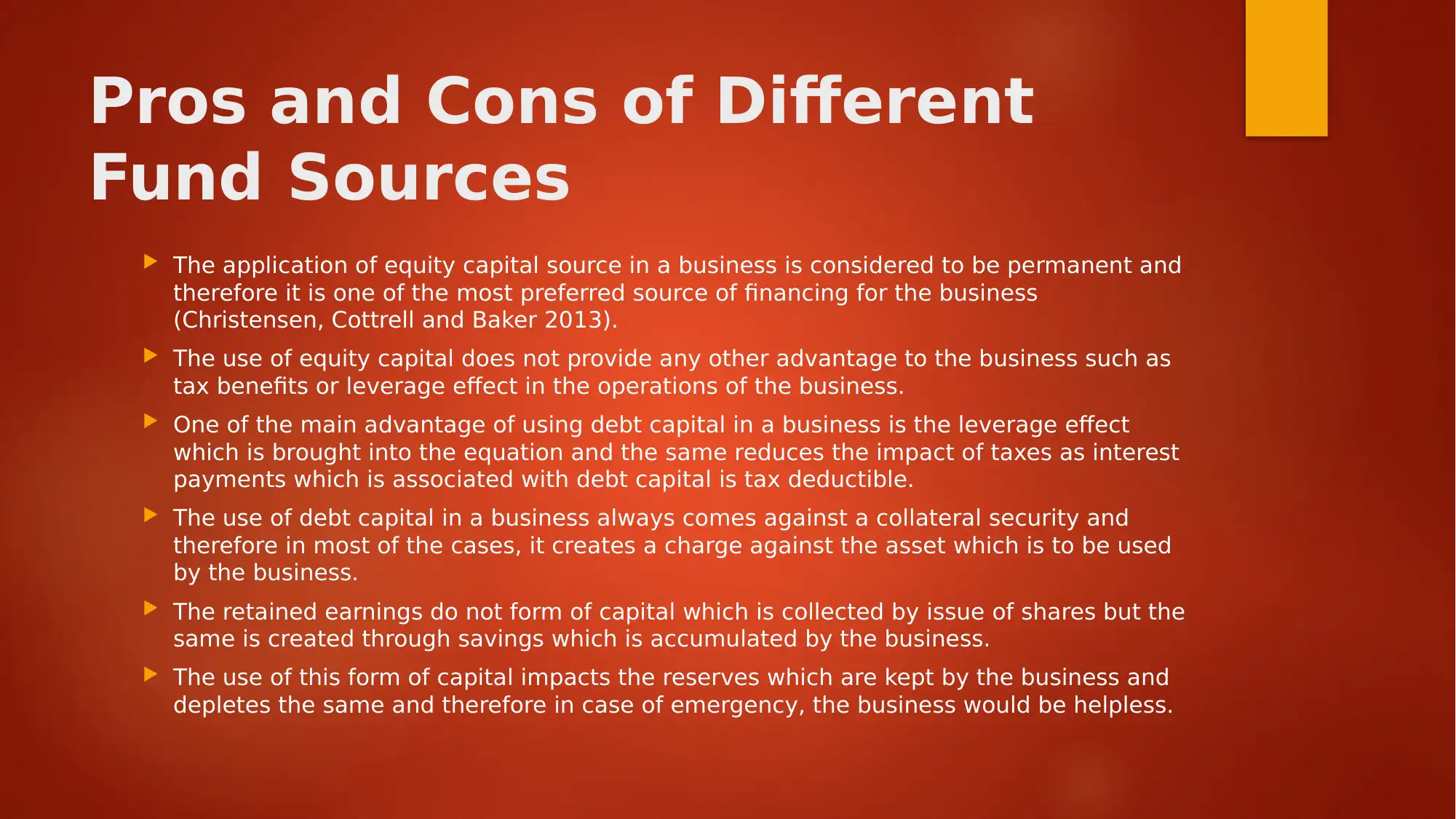
Pros and Cons of Different
Fund Sources
The application of equity capital source in a business is considered to be permanent and
therefore it is one of the most preferred source of financing for the business
(Christensen, Cottrell and Baker 2013).
The use of equity capital does not provide any other advantage to the business such as
tax benefits or leverage effect in the operations of the business.
One of the main advantage of using debt capital in a business is the leverage effect
which is brought into the equation and the same reduces the impact of taxes as interest
payments which is associated with debt capital is tax deductible.
The use of debt capital in a business always comes against a collateral security and
therefore in most of the cases, it creates a charge against the asset which is to be used
by the business.
The retained earnings do not form of capital which is collected by issue of shares but the
same is created through savings which is accumulated by the business.
The use of this form of capital impacts the reserves which are kept by the business and
depletes the same and therefore in case of emergency, the business would be helpless.
Fund Sources
The application of equity capital source in a business is considered to be permanent and
therefore it is one of the most preferred source of financing for the business
(Christensen, Cottrell and Baker 2013).
The use of equity capital does not provide any other advantage to the business such as
tax benefits or leverage effect in the operations of the business.
One of the main advantage of using debt capital in a business is the leverage effect
which is brought into the equation and the same reduces the impact of taxes as interest
payments which is associated with debt capital is tax deductible.
The use of debt capital in a business always comes against a collateral security and
therefore in most of the cases, it creates a charge against the asset which is to be used
by the business.
The retained earnings do not form of capital which is collected by issue of shares but the
same is created through savings which is accumulated by the business.
The use of this form of capital impacts the reserves which are kept by the business and
depletes the same and therefore in case of emergency, the business would be helpless.
Paraphrase This Document
Need a fresh take? Get an instant paraphrase of this document with our AI Paraphraser
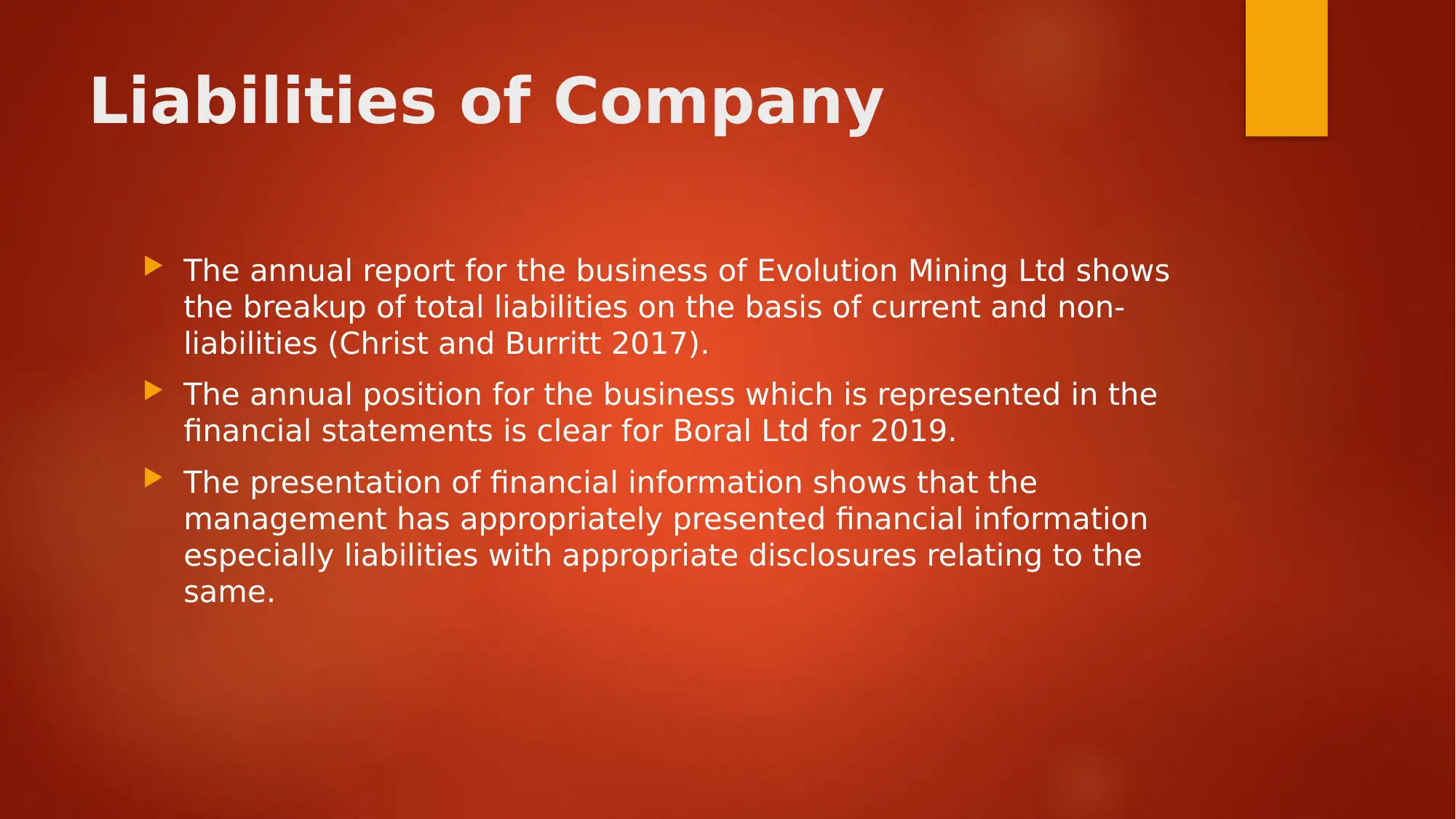
Liabilities of Company
The annual report for the business of Evolution Mining Ltd shows
the breakup of total liabilities on the basis of current and non-
liabilities (Christ and Burritt 2017).
The annual position for the business which is represented in the
financial statements is clear for Boral Ltd for 2019.
The presentation of financial information shows that the
management has appropriately presented financial information
especially liabilities with appropriate disclosures relating to the
same.
The annual report for the business of Evolution Mining Ltd shows
the breakup of total liabilities on the basis of current and non-
liabilities (Christ and Burritt 2017).
The annual position for the business which is represented in the
financial statements is clear for Boral Ltd for 2019.
The presentation of financial information shows that the
management has appropriately presented financial information
especially liabilities with appropriate disclosures relating to the
same.
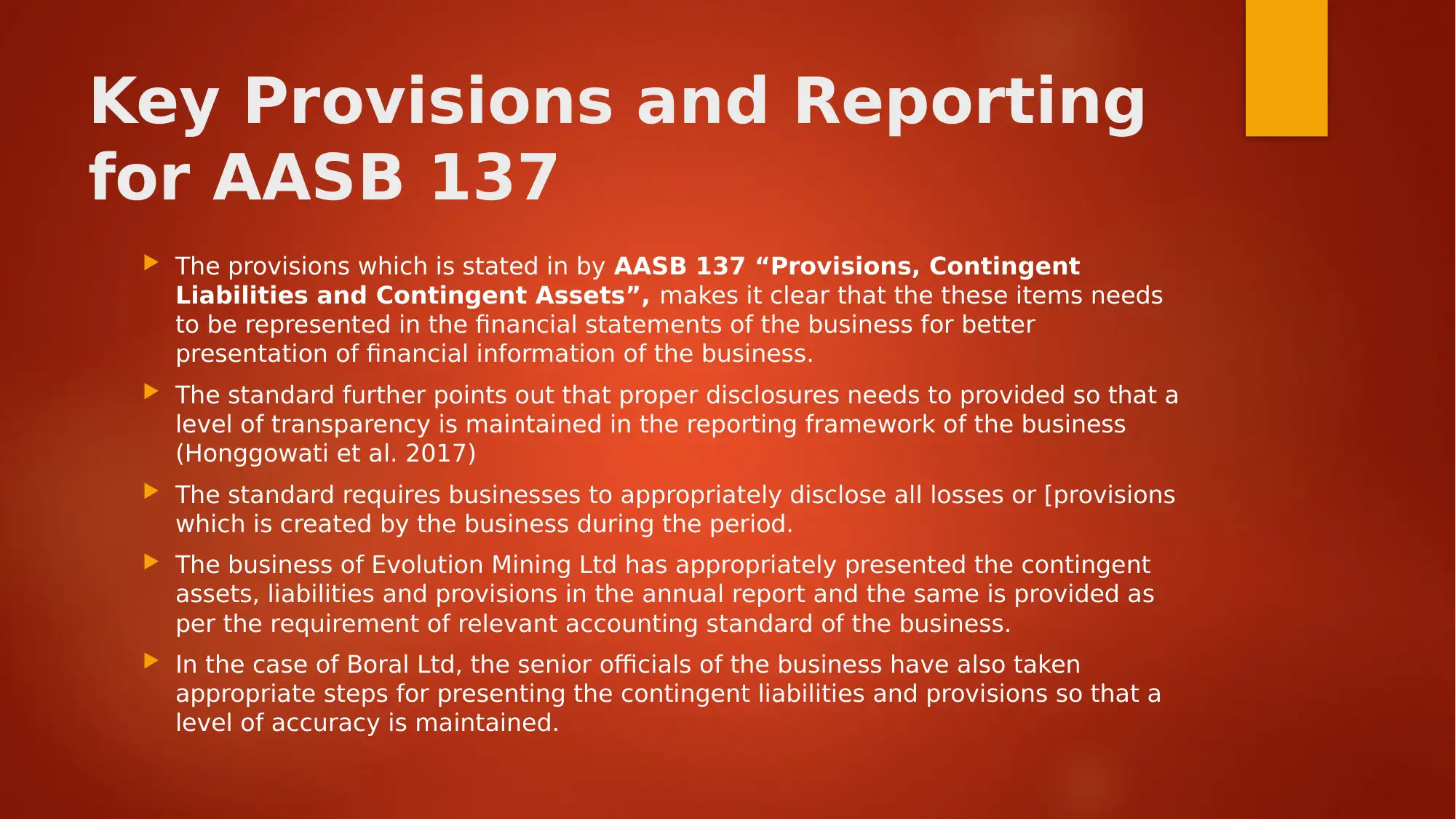
Key Provisions and Reporting
for AASB 137
The provisions which is stated in by AASB 137 “Provisions, Contingent
Liabilities and Contingent Assets”, makes it clear that the these items needs
to be represented in the financial statements of the business for better
presentation of financial information of the business.
The standard further points out that proper disclosures needs to provided so that a
level of transparency is maintained in the reporting framework of the business
(Honggowati et al. 2017)
The standard requires businesses to appropriately disclose all losses or [provisions
which is created by the business during the period.
The business of Evolution Mining Ltd has appropriately presented the contingent
assets, liabilities and provisions in the annual report and the same is provided as
per the requirement of relevant accounting standard of the business.
In the case of Boral Ltd, the senior officials of the business have also taken
appropriate steps for presenting the contingent liabilities and provisions so that a
level of accuracy is maintained.
for AASB 137
The provisions which is stated in by AASB 137 “Provisions, Contingent
Liabilities and Contingent Assets”, makes it clear that the these items needs
to be represented in the financial statements of the business for better
presentation of financial information of the business.
The standard further points out that proper disclosures needs to provided so that a
level of transparency is maintained in the reporting framework of the business
(Honggowati et al. 2017)
The standard requires businesses to appropriately disclose all losses or [provisions
which is created by the business during the period.
The business of Evolution Mining Ltd has appropriately presented the contingent
assets, liabilities and provisions in the annual report and the same is provided as
per the requirement of relevant accounting standard of the business.
In the case of Boral Ltd, the senior officials of the business have also taken
appropriate steps for presenting the contingent liabilities and provisions so that a
level of accuracy is maintained.
⊘ This is a preview!⊘
Do you want full access?
Subscribe today to unlock all pages.

Trusted by 1+ million students worldwide
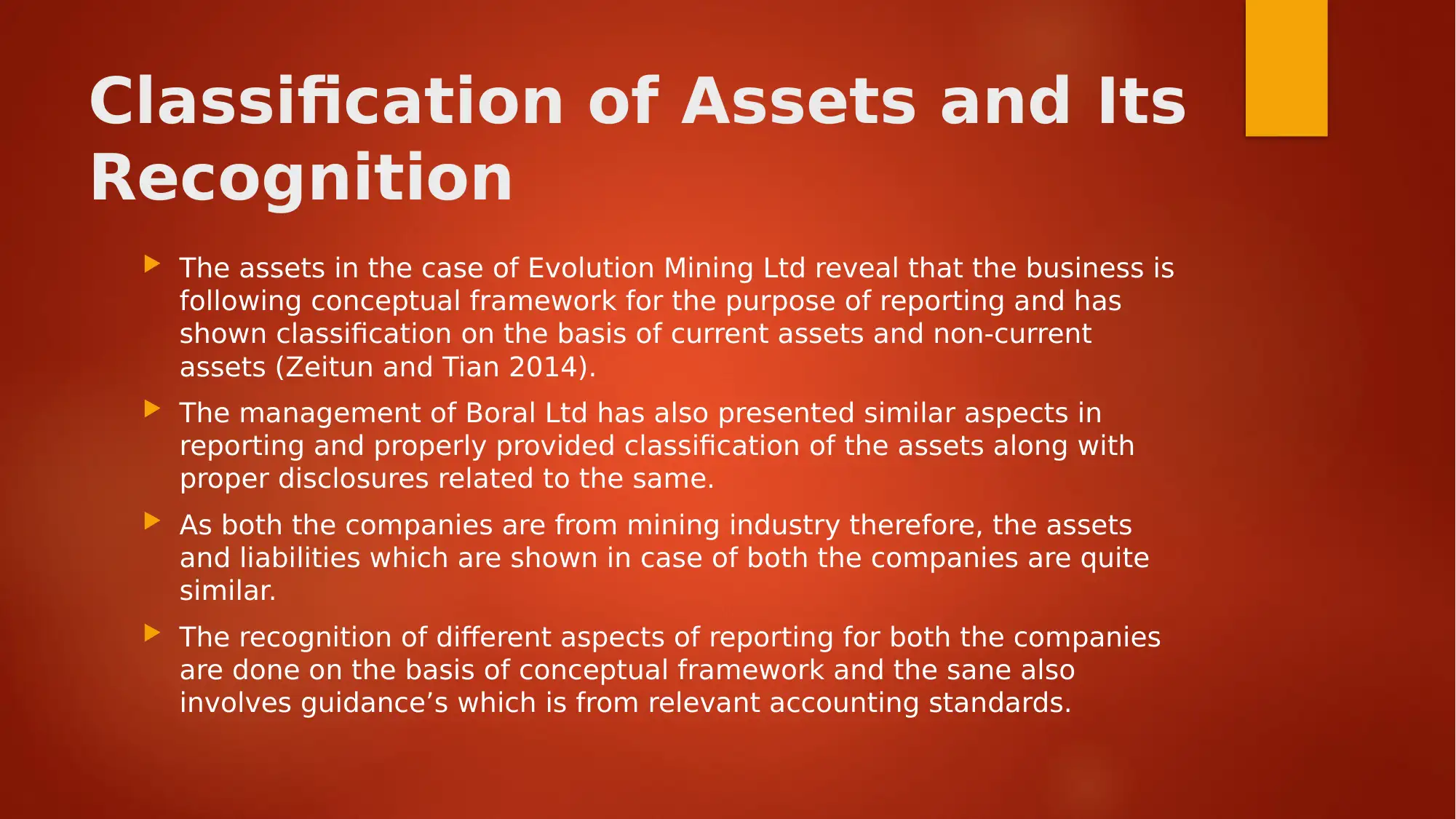
Classification of Assets and Its
Recognition
The assets in the case of Evolution Mining Ltd reveal that the business is
following conceptual framework for the purpose of reporting and has
shown classification on the basis of current assets and non-current
assets (Zeitun and Tian 2014).
The management of Boral Ltd has also presented similar aspects in
reporting and properly provided classification of the assets along with
proper disclosures related to the same.
As both the companies are from mining industry therefore, the assets
and liabilities which are shown in case of both the companies are quite
similar.
The recognition of different aspects of reporting for both the companies
are done on the basis of conceptual framework and the sane also
involves guidance’s which is from relevant accounting standards.
Recognition
The assets in the case of Evolution Mining Ltd reveal that the business is
following conceptual framework for the purpose of reporting and has
shown classification on the basis of current assets and non-current
assets (Zeitun and Tian 2014).
The management of Boral Ltd has also presented similar aspects in
reporting and properly provided classification of the assets along with
proper disclosures related to the same.
As both the companies are from mining industry therefore, the assets
and liabilities which are shown in case of both the companies are quite
similar.
The recognition of different aspects of reporting for both the companies
are done on the basis of conceptual framework and the sane also
involves guidance’s which is from relevant accounting standards.
Paraphrase This Document
Need a fresh take? Get an instant paraphrase of this document with our AI Paraphraser
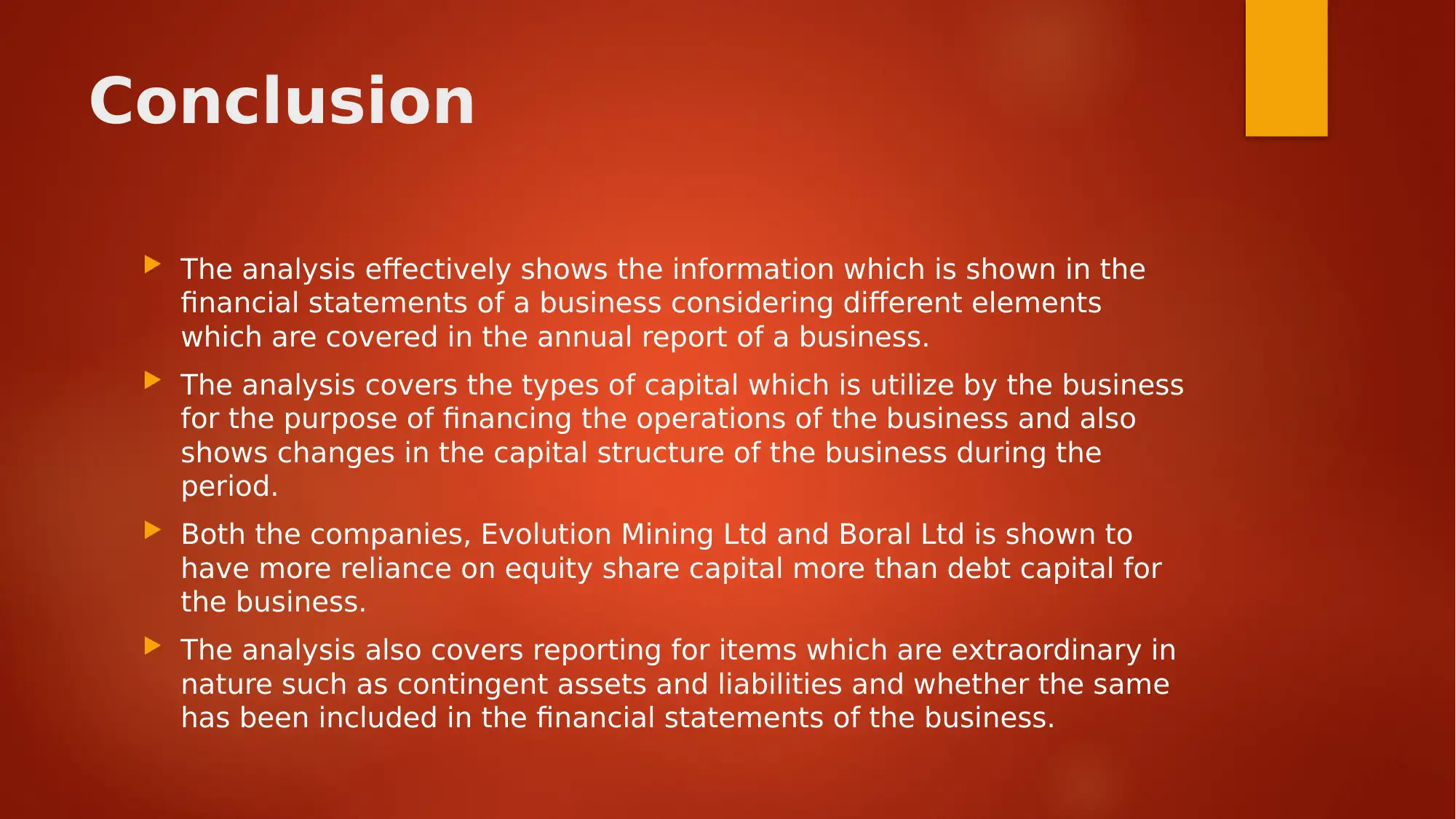
Conclusion
The analysis effectively shows the information which is shown in the
financial statements of a business considering different elements
which are covered in the annual report of a business.
The analysis covers the types of capital which is utilize by the business
for the purpose of financing the operations of the business and also
shows changes in the capital structure of the business during the
period.
Both the companies, Evolution Mining Ltd and Boral Ltd is shown to
have more reliance on equity share capital more than debt capital for
the business.
The analysis also covers reporting for items which are extraordinary in
nature such as contingent assets and liabilities and whether the same
has been included in the financial statements of the business.
The analysis effectively shows the information which is shown in the
financial statements of a business considering different elements
which are covered in the annual report of a business.
The analysis covers the types of capital which is utilize by the business
for the purpose of financing the operations of the business and also
shows changes in the capital structure of the business during the
period.
Both the companies, Evolution Mining Ltd and Boral Ltd is shown to
have more reliance on equity share capital more than debt capital for
the business.
The analysis also covers reporting for items which are extraordinary in
nature such as contingent assets and liabilities and whether the same
has been included in the financial statements of the business.
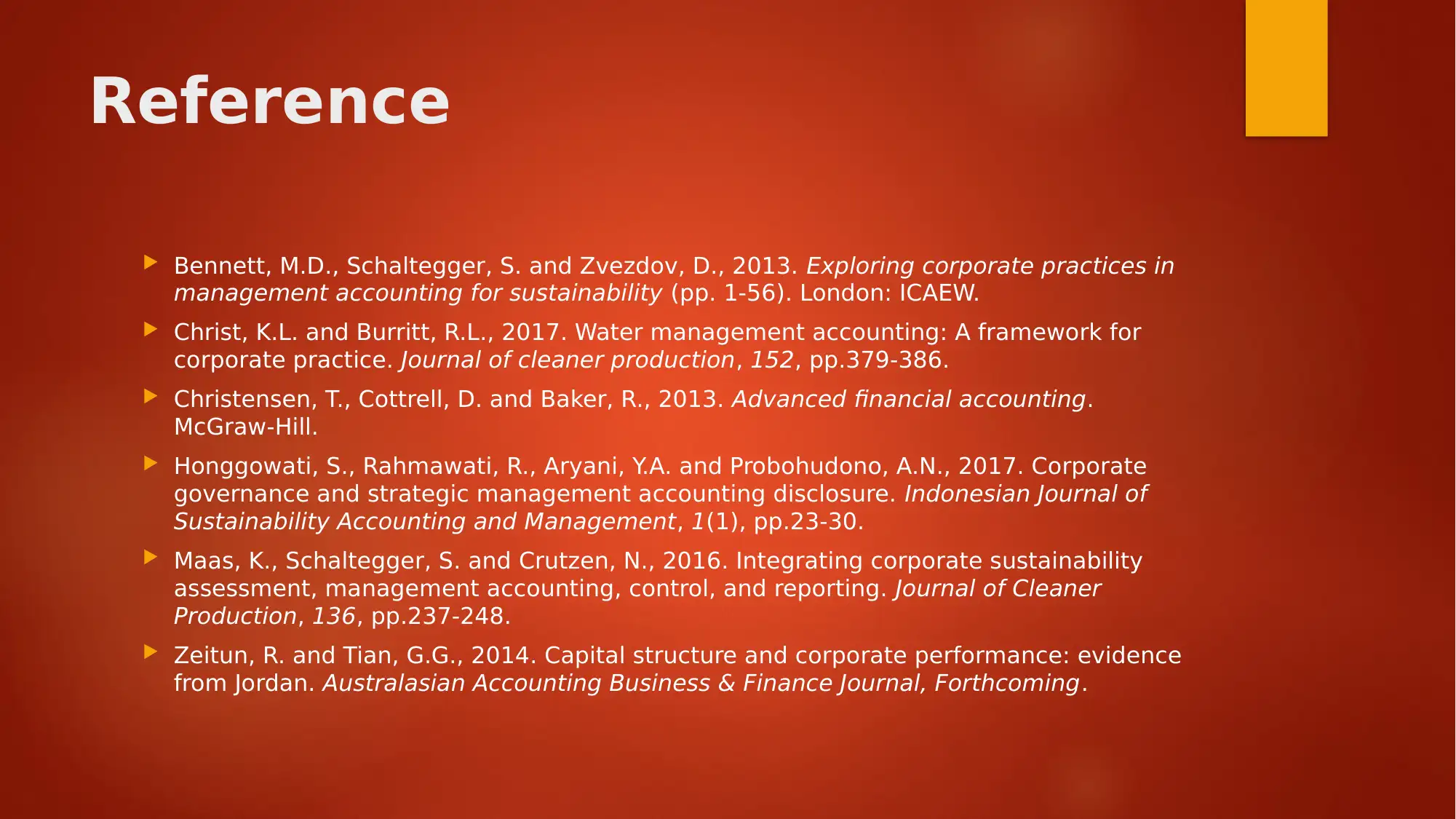
Reference
Bennett, M.D., Schaltegger, S. and Zvezdov, D., 2013. Exploring corporate practices in
management accounting for sustainability (pp. 1-56). London: ICAEW.
Christ, K.L. and Burritt, R.L., 2017. Water management accounting: A framework for
corporate practice. Journal of cleaner production, 152, pp.379-386.
Christensen, T., Cottrell, D. and Baker, R., 2013. Advanced financial accounting.
McGraw-Hill.
Honggowati, S., Rahmawati, R., Aryani, Y.A. and Probohudono, A.N., 2017. Corporate
governance and strategic management accounting disclosure. Indonesian Journal of
Sustainability Accounting and Management, 1(1), pp.23-30.
Maas, K., Schaltegger, S. and Crutzen, N., 2016. Integrating corporate sustainability
assessment, management accounting, control, and reporting. Journal of Cleaner
Production, 136, pp.237-248.
Zeitun, R. and Tian, G.G., 2014. Capital structure and corporate performance: evidence
from Jordan. Australasian Accounting Business & Finance Journal, Forthcoming.
Bennett, M.D., Schaltegger, S. and Zvezdov, D., 2013. Exploring corporate practices in
management accounting for sustainability (pp. 1-56). London: ICAEW.
Christ, K.L. and Burritt, R.L., 2017. Water management accounting: A framework for
corporate practice. Journal of cleaner production, 152, pp.379-386.
Christensen, T., Cottrell, D. and Baker, R., 2013. Advanced financial accounting.
McGraw-Hill.
Honggowati, S., Rahmawati, R., Aryani, Y.A. and Probohudono, A.N., 2017. Corporate
governance and strategic management accounting disclosure. Indonesian Journal of
Sustainability Accounting and Management, 1(1), pp.23-30.
Maas, K., Schaltegger, S. and Crutzen, N., 2016. Integrating corporate sustainability
assessment, management accounting, control, and reporting. Journal of Cleaner
Production, 136, pp.237-248.
Zeitun, R. and Tian, G.G., 2014. Capital structure and corporate performance: evidence
from Jordan. Australasian Accounting Business & Finance Journal, Forthcoming.
⊘ This is a preview!⊘
Do you want full access?
Subscribe today to unlock all pages.

Trusted by 1+ million students worldwide

1 out of 10
Related Documents
Your All-in-One AI-Powered Toolkit for Academic Success.
+13062052269
info@desklib.com
Available 24*7 on WhatsApp / Email
![[object Object]](/_next/static/media/star-bottom.7253800d.svg)
Unlock your academic potential
Copyright © 2020–2025 A2Z Services. All Rights Reserved. Developed and managed by ZUCOL.



